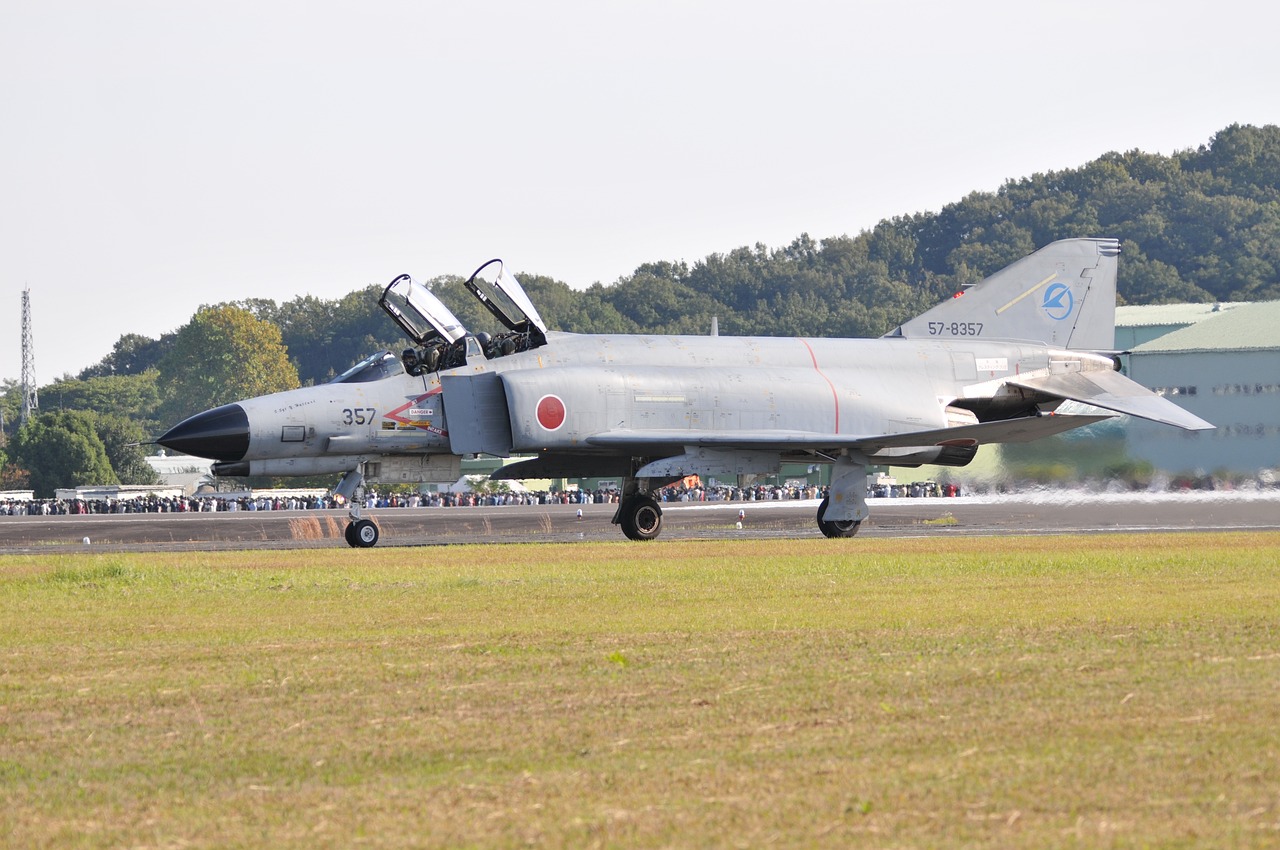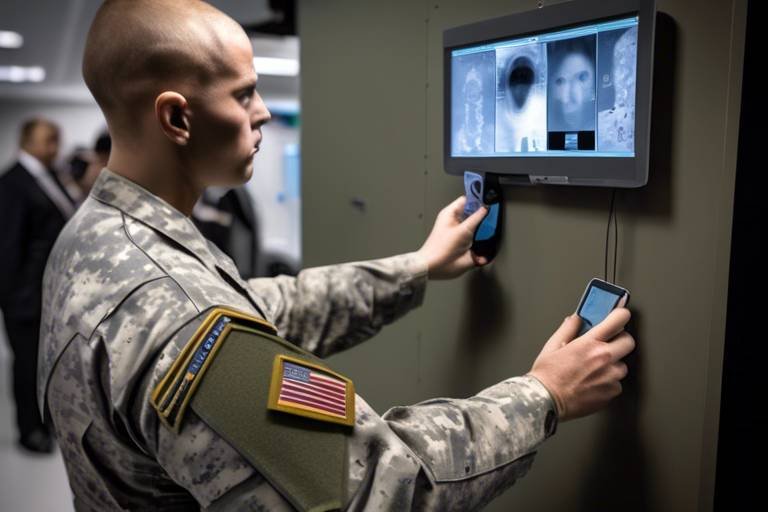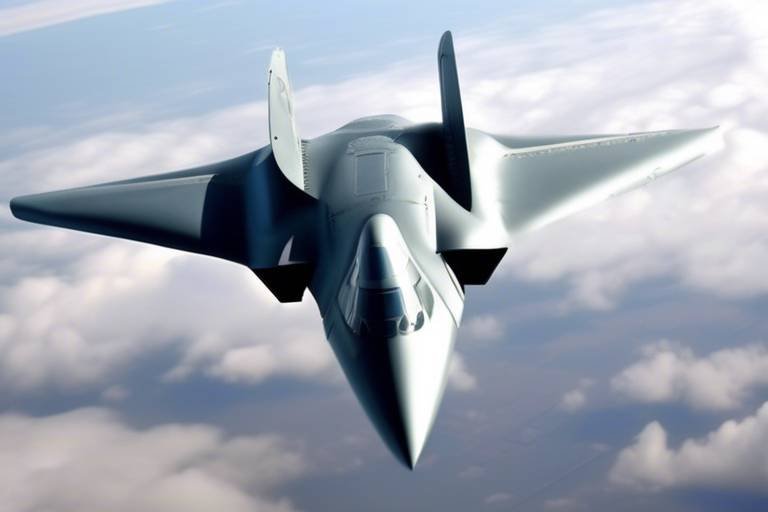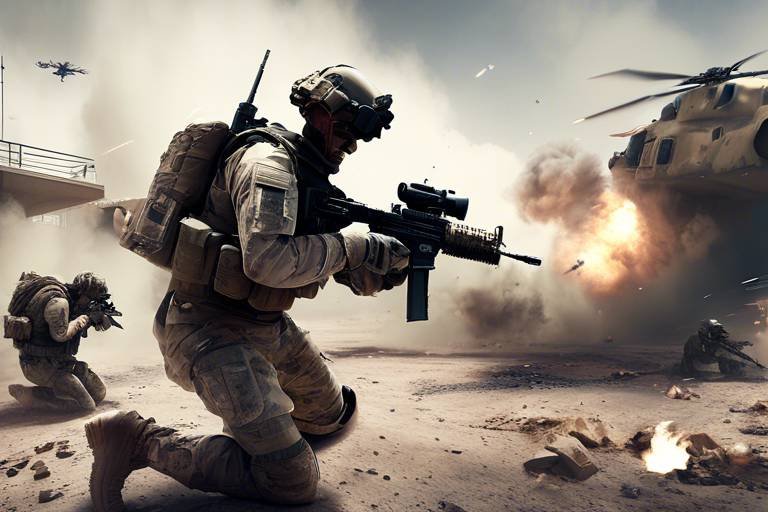Exploring AI-Powered Defense Systems in Ground Combat
In recent years, the battlefield has undergone a dramatic transformation, with artificial intelligence (AI) emerging as a game-changer in military operations. The integration of AI into defense systems is not just a futuristic concept; it is happening right now, and its implications are profound. Imagine a world where machines can analyze vast amounts of data in seconds, predict enemy movements, and assist human operators in making critical decisions. This is the reality that AI is creating for ground combat. As we delve deeper into this topic, we will explore how these advanced technologies are reshaping military strategies, enhancing operational efficiency, and ultimately influencing the outcome of ground combat missions.
One of the most exciting aspects of AI in military applications is its ability to enhance decision-making. Commanders are often faced with a plethora of information that must be processed quickly to make informed choices. AI systems can sift through this data, providing actionable insights that can be the difference between success and failure on the battlefield. For instance, in a rapidly changing combat environment, AI can help identify threats and opportunities that a human might overlook. This capability not only speeds up the decision-making process but also increases the accuracy of the decisions made.
Moreover, AI-powered defense systems can significantly improve situational awareness. By aggregating data from various sources—such as drones, satellites, and ground sensors—AI can create a comprehensive picture of the battlefield. This enhanced awareness allows military personnel to anticipate enemy actions and react accordingly, which is crucial in ground combat scenarios. Imagine having a 360-degree view of the battlefield, where every movement is tracked and analyzed in real time. This is the potential that AI brings to military operations.
However, it's essential to acknowledge that the integration of AI in defense systems is not without its challenges. There are significant ethical concerns regarding the autonomy of AI in combat situations, particularly when it comes to decision-making that could result in loss of life. Additionally, the reliance on technology raises questions about cybersecurity. What happens if an enemy hacks into these systems? The implications could be catastrophic. Therefore, as we continue to explore the potential of AI in ground combat, we must also address these challenges to ensure that these systems are used responsibly and effectively.
Looking ahead, the future of AI in ground combat is not just about improving existing technologies but also about innovation. Research and development are ongoing, with emerging technologies that promise to further enhance defense systems. For instance, advancements in machine learning and data analytics could lead to even more sophisticated predictive capabilities. This means that AI could not only respond to current threats but also anticipate future ones, allowing military forces to stay one step ahead of their adversaries.
As we embrace these advancements, the integration of AI with existing military systems becomes crucial. This integration is not merely a technical challenge but also a strategic one. It requires collaboration between engineers, military strategists, and human operators to ensure that AI systems complement rather than replace human decision-making. The goal is to create a hybrid approach where AI enhances the capabilities of human operators, leading to more effective ground combat operations.
In conclusion, the exploration of AI-powered defense systems in ground combat reveals a landscape filled with potential and challenges. The benefits are clear, from improved decision-making to enhanced situational awareness, but so are the ethical and cybersecurity concerns that must be addressed. As we move forward, the collaboration between human operators and AI will be pivotal in shaping the future of military operations. The question remains: are we ready to embrace this new era of warfare?
- What are AI-powered defense systems?
These are military technologies that utilize artificial intelligence to enhance decision-making, situational awareness, and operational efficiency on the battlefield.
- How does AI improve decision-making in combat?
AI analyzes vast amounts of data in real-time, providing commanders with actionable insights that help them make informed decisions quickly.
- What are the ethical concerns surrounding AI in military applications?
Concerns include the autonomy of AI in making life-and-death decisions, as well as the potential for cybersecurity vulnerabilities.
- What is the future of AI in ground combat?
The future involves ongoing research and development, focusing on innovations that enhance predictive capabilities and improve integration with existing military systems.

Understanding AI in Military Applications
Artificial intelligence (AI) is not just a buzzword; it’s a game changer in the world of military operations. Imagine a battlefield where decisions are made not just based on human intuition but also on real-time data analysis and predictive modeling. This is the reality that AI is bringing to the forefront of military strategy. By integrating AI technologies into defense strategies, military forces are enhancing their decision-making, improving situational awareness, and boosting operational efficiency.
One of the most fascinating aspects of AI in military applications is its ability to process vast amounts of information at lightning speed. In a combat scenario, where every second counts, having the capability to analyze data from various sources—such as satellite imagery, drone feeds, and ground sensors—can provide commanders with a crucial edge. This data integration allows for a more comprehensive understanding of the battlefield, enabling military leaders to anticipate enemy movements and make informed decisions quickly.
Furthermore, AI systems can learn from historical data and adapt their algorithms to improve over time. This means that the more they are used, the better they become at predicting outcomes and suggesting strategies. For instance, AI can analyze patterns in enemy behavior and suggest optimal countermeasures, effectively turning historical analysis into actionable insights.
However, the implementation of AI in military operations doesn't come without challenges. The integration of these advanced technologies requires significant investment and training. Military personnel must be equipped not only with the technical skills to operate these systems but also with the critical thinking skills to interpret AI-generated data effectively. Moreover, the reliance on AI raises important ethical questions about the autonomy of machines in decision-making processes, particularly in life-and-death situations.
To put it simply, AI is reshaping the way militaries operate, but it’s a double-edged sword. While it offers numerous advantages, it also necessitates a careful approach to ensure that the technology is used responsibly and effectively. As we delve deeper into the implications of AI in military applications, it becomes evident that understanding both its potential and its limitations is crucial for future developments in defense strategies.
- What is AI's role in military applications? AI enhances decision-making, situational awareness, and operational efficiency in military operations.
- How does AI improve decision-making on the battlefield? AI analyzes vast amounts of data in real-time, providing commanders with actionable insights to make informed decisions quickly.
- Are there ethical concerns regarding AI in military operations? Yes, there are significant ethical considerations, especially regarding the autonomy of machines in life-and-death decisions.
- What challenges does the military face in integrating AI? The military must invest in technology, training, and address ethical implications to effectively implement AI systems.

Benefits of AI-Powered Defense Systems
AI-powered defense systems are revolutionizing the landscape of military operations, bringing a plethora of benefits that are reshaping how ground combat is conducted. One of the most significant advantages is the improved accuracy of targeting systems. Traditional methods often involve human error, which can lead to costly mistakes on the battlefield. However, with AI algorithms analyzing data from various sensors and reconnaissance tools, the precision of strikes can be enhanced dramatically. Imagine a world where a drone can identify and engage a target with pinpoint accuracy, reducing collateral damage and ensuring mission success.
Another key benefit of AI in defense systems is the faster response times. In the heat of battle, every second counts. AI can process information at lightning speed, allowing military personnel to react swiftly to emerging threats. For instance, when an enemy force is detected, AI systems can quickly evaluate the situation, assess potential risks, and recommend the best course of action. This rapid decision-making capability can be the difference between victory and defeat.
Moreover, AI significantly reduces human error. In high-pressure situations, even the most experienced operators can make mistakes. AI systems, on the other hand, operate on data and algorithms, which means they can maintain a level of consistency that humans might struggle to achieve under stress. This reliability is crucial in ground combat scenarios where the stakes are incredibly high.
To further illustrate these benefits, consider the following table that summarizes the advantages of AI-powered defense systems:
| Benefit | Description |
|---|---|
| Improved Accuracy | AI enhances targeting precision, reducing collateral damage. |
| Faster Response Times | AI enables rapid decision-making, crucial in dynamic combat environments. |
| Reduced Human Error | AI systems provide consistency and reliability in high-pressure situations. |
Furthermore, the integration of AI in defense systems fosters better situational awareness. By processing vast amounts of data from different sources, AI can provide commanders with a comprehensive view of the battlefield. This includes real-time updates on troop movements, enemy positions, and environmental conditions. With such insights, military leaders can make informed decisions that improve the overall effectiveness of their operations.
Lastly, AI-powered defense systems can enhance logistical support. From predicting equipment failures to optimizing supply routes, AI can streamline various logistical operations. This efficiency not only saves time but also ensures that troops have the necessary resources when they need them most. Think of it like having a personal assistant who knows exactly what you need before you even ask!
In summary, the benefits of AI-powered defense systems are profound and multifaceted. They not only improve accuracy and speed but also enhance overall mission success by reducing human error and providing better situational awareness. As military technology continues to evolve, the integration of AI will undoubtedly play a pivotal role in shaping the future of ground combat.
- What are the main advantages of AI in military applications? AI improves accuracy, speeds up response times, reduces human error, and enhances situational awareness.
- How does AI enhance decision-making in combat? AI analyzes vast amounts of data quickly, allowing commanders to make informed decisions in real time.
- Are there any risks associated with AI-powered defense systems? Yes, there are challenges such as ethical concerns, potential cybersecurity threats, and the need for robust oversight.

Enhanced Decision-Making
In the fast-paced world of ground combat, the ability to make swift and informed decisions can mean the difference between mission success and failure. This is where AI-powered systems come into play, revolutionizing the way military commanders approach tactical decision-making. Imagine having a virtual assistant that not only provides real-time data but also analyzes it to offer actionable insights. That's the power of AI in modern warfare.
AI systems can process vast amounts of information from various sources, including satellite imagery, drone footage, and ground reports, in a fraction of the time it would take a human. This capability allows military leaders to gain a comprehensive view of the battlefield, enhancing their situational awareness. For instance, while a traditional command center might rely on a few officers to sift through reports and data, an AI system can integrate and analyze that information simultaneously, presenting commanders with a clear and concise overview of the current situation.
Furthermore, the enhanced decision-making capabilities of AI extend beyond mere data analysis. These systems utilize complex algorithms to identify patterns and predict outcomes based on historical data. This predictive capability can be crucial in anticipating enemy movements and potential threats. For example, if an AI system detects a sudden increase in troop movements in a specific area, it can alert commanders to potential ambushes or surprise attacks, allowing them to adjust their strategies accordingly.
To illustrate this point, let's consider a hypothetical scenario:
| Scenario | Traditional Decision-Making | AI-Powered Decision-Making |
|---|---|---|
| Enemy Troop Movements Detected | Commanders review reports, discuss options, and decide on a course of action (time-consuming). | AI analyzes data, predicts enemy intentions, and suggests optimal response strategies in real-time (swift and efficient). |
This table highlights a stark contrast in decision-making speed and efficiency. In a combat environment where every second counts, the ability to access and act on critical information rapidly can significantly enhance operational effectiveness.
Moreover, AI's role in decision-making is not just about speed; it's also about reducing the likelihood of human error. In high-stress scenarios, fatigue and stress can cloud judgment. AI systems, however, maintain their analytical capabilities without succumbing to these pressures, ensuring that decisions are based on data rather than emotions or fatigue. This is particularly important in ground combat, where the stakes are incredibly high.
In conclusion, the integration of AI into military decision-making processes represents a transformative shift in how ground combat operations are conducted. By providing commanders with enhanced situational awareness, predictive analytics, and the ability to process vast amounts of data quickly, AI empowers military leaders to make informed decisions that can lead to successful outcomes on the battlefield.
- How does AI improve decision-making in military operations?
AI enhances decision-making by analyzing large datasets quickly, providing real-time insights, and predicting potential threats based on historical patterns. - What are the risks associated with AI in military applications?
Risks include reliance on technology, potential for cybersecurity threats, and ethical concerns regarding autonomous decision-making. - Can AI completely replace human decision-making in combat?
No, AI is designed to assist human operators, not replace them. Human judgment is still critical in complex and unpredictable combat situations. - What future developments can we expect in AI-powered defense systems?
Future developments may include improved integration with existing military systems, enhanced machine learning algorithms, and better collaboration between AI and human operators.

Data Processing Capabilities
The ability of artificial intelligence to process and analyze vast amounts of data in real-time is nothing short of revolutionary, especially in the context of military operations. Imagine a battlefield where information flows in like a raging river, with data streams coming from drones, satellites, ground sensors, and even social media. AI acts as a powerful dam, channeling this torrent of information into actionable insights. This capability not only enhances situational awareness but also provides commanders with a clearer picture of the operational environment. By sifting through this data, AI can identify patterns, detect anomalies, and highlight potential threats that might go unnoticed by human analysts.
One of the most striking aspects of AI's data processing capabilities is its speed. Traditional methods of data analysis can take hours or even days, but AI can deliver insights in mere seconds. This rapid processing allows military leaders to make decisions based on the most current information available, effectively reducing the reaction time to threats and improving overall mission success. For instance, if an enemy unit is detected moving towards a strategic location, AI can quickly analyze the situation, assess the potential impact, and recommend tactical responses, all while the clock is ticking.
Moreover, AI's data processing extends beyond just immediate threats. It can aggregate historical data to provide predictive insights, helping military strategists anticipate future actions based on past behavior. This predictive capability is crucial in modern warfare, where understanding an adversary's next move can be the difference between victory and defeat. By employing algorithms that learn and adapt, AI systems can refine their predictions over time, becoming increasingly effective as they are exposed to more data.
To illustrate the effectiveness of AI in data processing, consider the following table that compares traditional data analysis methods with AI-enhanced approaches:
| Aspect | Traditional Methods | AI-Enhanced Methods |
|---|---|---|
| Speed of Analysis | Hours to Days | Seconds to Minutes |
| Data Sources | Limited | Multiple Sources (Drones, Satellites, Sensors) |
| Pattern Recognition | Manual | Automated and Adaptive |
| Predictive Capabilities | Static | Dynamic and Learning |
In conclusion, the data processing capabilities of AI not only streamline the flow of information but also enhance the quality of decisions made during ground combat operations. By leveraging AI, military forces can achieve a level of situational awareness and predictive capability that was previously unimaginable. This transformation is not just about keeping pace with technological advancements; it’s about gaining a significant edge over adversaries in an increasingly complex and fast-paced battlefield environment.
- What is the main advantage of AI in data processing for military operations?
AI significantly speeds up the analysis of data, allowing military leaders to make informed decisions in real-time. - How does AI improve situational awareness on the battlefield?
By aggregating and analyzing data from multiple sources, AI provides a comprehensive view of the operational environment, helping commanders identify threats and opportunities quickly. - Can AI predict enemy movements?
Yes, AI utilizes historical data and advanced algorithms to forecast potential enemy actions, which can shape military strategies effectively.

Predictive Analytics
In the realm of military strategy, powered by artificial intelligence is nothing short of revolutionary. Imagine having the ability to foresee potential enemy movements and threats before they even materialize. This is not just a futuristic concept; it’s a reality that is reshaping how ground combat operations are conducted. By processing vast amounts of data from various sources—such as satellite imagery, reconnaissance reports, and historical combat data—AI systems can identify patterns and trends that human analysts might overlook.
One of the key advantages of predictive analytics is its capacity to enhance situational awareness. For instance, if an AI system detects unusual troop movements in a particular area, it can alert commanders to potential threats, allowing them to respond proactively rather than reactively. This proactive approach is crucial in modern warfare, where the speed of decision-making can determine the outcome of a mission. Furthermore, predictive analytics can assist in resource allocation, ensuring that troops and supplies are positioned optimally to counter anticipated threats.
Moreover, the integration of predictive analytics into military operations can lead to more effective training programs. By analyzing past engagements and identifying what strategies worked or failed, military leaders can tailor training exercises to better prepare their forces for similar scenarios. This not only enhances the readiness of troops but also fosters a culture of continuous improvement within military organizations.
However, while the benefits of predictive analytics are substantial, it is essential to approach this technology with a balanced perspective. The accuracy of predictions relies heavily on the quality of data inputted into the system. Inaccurate or biased data can lead to flawed predictions, potentially putting troops at risk. Therefore, ensuring robust data collection and validation processes is paramount.
In conclusion, predictive analytics represents a significant leap forward for military strategy and ground combat operations. By harnessing the power of AI to anticipate enemy actions and optimize resource deployment, military forces can enhance their effectiveness on the battlefield. As technology continues to evolve, the potential applications of predictive analytics in defense will only expand, paving the way for a new era of military operations.
- What is predictive analytics in military applications?
Predictive analytics involves using AI to analyze data and forecast potential enemy actions and threats, enhancing strategic decision-making. - How does predictive analytics improve situational awareness?
It processes data from various sources to identify patterns that alert commanders to unusual activities, enabling proactive responses. - What are the risks associated with predictive analytics?
Inaccurate or biased data can lead to flawed predictions, which may jeopardize military operations. Ensuring data quality is essential. - How can predictive analytics enhance military training?
By analyzing past engagements, military leaders can tailor training programs to better prepare troops for real-world scenarios.

Challenges and Limitations
As we leap into the future with AI-powered defense systems, it’s essential to recognize that this technology, while revolutionary, is not without its share of challenges and limitations. Just like a double-edged sword, AI brings both incredible potential and significant hurdles that military strategists must navigate. One of the primary concerns is the ethical implications of using AI in combat. The idea of machines making life-and-death decisions raises profound moral questions. Who is accountable if an AI system makes a mistake? This uncertainty can lead to a lack of trust among military personnel, which is crucial in high-stakes environments.
Moreover, the integration of AI into existing military frameworks poses its own set of challenges. Many current systems were not designed with AI in mind, leading to potential compatibility issues. This can create a fragmented operational landscape where traditional systems and AI-driven technologies struggle to communicate effectively. The need for seamless integration cannot be overstated, as any gaps can lead to vulnerabilities on the battlefield.
Another pressing issue is cybersecurity. As AI systems become more prevalent, they also become more attractive targets for cyberattacks. Hackers may attempt to manipulate or disable these systems, potentially leading to catastrophic outcomes. The military must invest heavily in robust cybersecurity measures to protect AI technologies from malicious actors. The risk of hacking is not just a theoretical concern; it’s a real threat that could compromise national security.
Additionally, there are concerns regarding data bias. AI systems learn from data, and if that data is flawed or biased, the AI's decisions will also be flawed. This can lead to unfair treatment of certain groups or incorrect assessments in combat situations. It’s crucial for military developers to ensure that the data used to train AI systems is comprehensive and unbiased, which is often easier said than done.
Lastly, the reliance on AI technology could lead to a reduction in human skills over time. If military personnel become overly dependent on AI for decision-making, they may lose the critical thinking and tactical skills necessary for effective ground combat. This creates a paradox where the very technology designed to enhance human capabilities could, in fact, diminish them.
In summary, while the potential of AI in ground combat is immense, it comes with challenges that must be addressed. From ethical dilemmas and integration issues to cybersecurity threats and data bias, the road ahead is fraught with obstacles. However, by acknowledging these limitations and working towards solutions, the military can harness the full power of AI to enhance its defense capabilities.
- What are the main ethical concerns regarding AI in military applications?
Ethical concerns include accountability for decisions made by AI, potential biases in AI algorithms, and the moral implications of allowing machines to engage in combat. - How does cybersecurity impact AI-powered defense systems?
AI systems are vulnerable to cyberattacks, which can manipulate their functions or disable them, posing risks to national security. - Can AI replace human decision-making in military operations?
While AI can enhance decision-making, it is crucial for human operators to remain involved to ensure accountability and critical thinking. - What are the risks of data bias in AI systems?
Data bias can lead to unfair treatment and incorrect assessments, undermining the effectiveness of AI in military operations.

Future Developments in AI Defense Technology
The future of AI in ground combat is not just a distant dream; it’s an evolving reality that’s already reshaping military landscapes around the world. As we look ahead, the integration of artificial intelligence into defense systems is poised to revolutionize how military operations are conducted. Imagine a battlefield where machines and humans work in perfect harmony, enhancing each other's strengths. This synergy is not merely theoretical; it’s a tangible goal that military strategists are actively pursuing.
One of the most exciting aspects of AI defense technology is the emergence of autonomous systems. These systems, equipped with advanced AI algorithms, can operate independently in complex environments, making split-second decisions that could mean the difference between success and failure in combat. For instance, drones powered by AI can conduct reconnaissance missions without direct human oversight, gathering vital intelligence while minimizing risk to personnel. This capability not only saves lives but also provides commanders with real-time data that can significantly enhance tactical planning.
Additionally, the integration of AI with existing military platforms is essential for maximizing effectiveness. Military forces around the globe are investing in research to ensure that new AI technologies can seamlessly work with legacy systems. This integration is crucial because it allows for a smoother transition and minimizes disruption during operations. For example, a tank equipped with AI could analyze battlefield conditions and suggest tactical maneuvers to its crew, enhancing their situational awareness and decision-making capabilities.
Moreover, the potential for collaboration between AI systems and human operators cannot be overstated. While AI can process vast amounts of data and identify patterns that humans might miss, it is the human element that brings creativity, intuition, and ethical considerations into the equation. Future developments will likely focus on creating user-friendly interfaces that allow human operators to interact with AI systems effortlessly. This collaboration is akin to having a seasoned co-pilot in the cockpit, where both parties contribute their unique strengths to achieve a common goal.
Another promising area of development is predictive analytics. AI can analyze historical data and current battlefield conditions to forecast enemy movements and potential threats. This foresight enables military commanders to proactively adjust their strategies, rather than merely reacting to unfolding events. For instance, if AI systems can predict an enemy's next move with a high degree of accuracy, it allows for preemptive strikes or defensive preparations, significantly enhancing operational effectiveness.
However, with these advancements come challenges that need to be addressed. The military must ensure that AI systems are secure from cyber threats, as vulnerabilities could be exploited by adversaries. Moreover, ethical considerations regarding the use of autonomous weapons systems must be carefully examined. The balance between leveraging AI for operational advantage and ensuring compliance with international laws and ethical standards will be a critical discussion in the coming years.
In conclusion, the future of AI in defense technology is bright, filled with opportunities for innovation and improvement. As military forces embrace these advancements, they will undoubtedly face challenges, but the potential benefits—enhanced decision-making, improved operational efficiency, and increased safety for personnel—are too significant to ignore. The next decade will be crucial in determining how these technologies are integrated and utilized on the battlefield.
- What are AI-powered defense systems?
AI-powered defense systems use artificial intelligence to enhance military operations, improving decision-making, situational awareness, and operational efficiency. - How does AI improve decision-making in ground combat?
AI analyzes vast amounts of data in real-time, enabling commanders to make informed decisions quickly and effectively. - What are the potential challenges of AI in military applications?
Challenges include ethical concerns, cybersecurity threats, and the need for seamless integration with existing systems. - How can AI predict enemy movements?
AI uses predictive analytics to analyze historical and real-time data, forecasting potential threats and movements.

Integration with Existing Systems
Integrating AI-powered defense systems with existing military frameworks is not just a technical challenge; it’s a strategic imperative. As the landscape of warfare evolves, the need for seamless integration becomes increasingly critical. Imagine trying to fit a high-performance engine into an old car; it requires not only the right tools but also a deep understanding of both the old and new systems. This analogy holds true in the military context as well.
One of the primary challenges is the heterogeneity of existing systems. Military forces around the world utilize a myriad of legacy systems that were designed before the advent of AI technologies. These systems often have different protocols, data formats, and operational procedures. Therefore, achieving interoperability between AI systems and these legacy frameworks is essential. For instance, if an AI system designed to analyze battlefield data cannot communicate effectively with existing surveillance technologies, the potential benefits of enhanced situational awareness may be lost.
Moreover, the integration process must also consider training and operational readiness. Military personnel need to be trained not only in using AI systems but also in understanding how these systems can complement traditional methods of warfare. This is where collaboration comes into play. By engaging with human operators throughout the integration process, military leaders can ensure that the systems are tailored to meet the specific needs of ground operations. This collaboration can take many forms, such as joint exercises, simulations, and feedback loops that allow for continuous improvement.
Additionally, it is crucial to adopt a phased approach to integration. Rather than attempting to overhaul entire systems at once, military planners can gradually introduce AI capabilities into existing operations. This strategy allows for real-time adjustments and minimizes the risk of operational disruption. For instance, starting with pilot programs that incorporate AI in specific combat scenarios can provide valuable insights into how these technologies can be scaled effectively across broader operations.
Furthermore, the integration of AI systems must adhere to strict cybersecurity protocols. As military operations become increasingly reliant on digital technologies, the threat of cyberattacks looms larger than ever. Ensuring that AI systems are secure from potential breaches is paramount. This involves not only protecting the AI systems themselves but also safeguarding the data they utilize. A breach could lead to compromised military strategies and tactics, which could have dire consequences on the battlefield.
In conclusion, the integration of AI-powered defense systems with existing military frameworks is a multifaceted challenge that requires careful planning, collaboration, and a commitment to ongoing training and cybersecurity. As we move forward into an era where AI plays a pivotal role in ground combat, the ability to effectively blend these advanced technologies with established practices will determine the success of military operations. The journey may be complex, but the potential rewards—enhanced operational effectiveness, improved decision-making, and ultimately, greater mission success—are well worth the effort.
- What are the main challenges of integrating AI with existing military systems?
Integration challenges include interoperability with legacy systems, the need for personnel training, and cybersecurity concerns. - How can military personnel be trained to use AI systems effectively?
Training can include simulations, joint exercises, and real-time feedback mechanisms to ensure personnel understand both AI capabilities and traditional methods. - Why is cybersecurity important in AI integration?
As military operations rely more on digital technologies, protecting AI systems from cyber threats is crucial to maintain operational integrity and security.

Collaboration with Human Operators
In the ever-evolving landscape of military technology, the collaboration between AI systems and human operators stands out as a crucial factor for success in ground combat missions. While AI brings remarkable capabilities to the table, such as rapid data processing and predictive analytics, the human element remains irreplaceable. Think of AI as a powerful engine that drives a sophisticated vehicle; without a skilled driver, that engine can’t navigate the complexities of the battlefield.
One of the key advantages of human-AI collaboration is the ability to combine the strengths of both entities. AI excels at processing vast amounts of information quickly, identifying patterns, and suggesting optimal strategies based on data analysis. However, human operators possess the intuition, experience, and moral judgment that AI lacks. This synergy allows for a more comprehensive approach to decision-making, where AI provides the data and insights, and humans apply their contextual understanding to make informed choices.
Moreover, the integration of AI systems into military operations requires a shift in training and operational protocols. Human operators need to be adept at interpreting AI-generated insights and incorporating them into their tactical plans. This means that military training programs must evolve to include not only traditional combat skills but also proficiency in AI technologies. For instance, operators might be trained to understand how to leverage machine learning algorithms to predict enemy movements or assess the effectiveness of various strategies.
Furthermore, the communication between AI systems and human operators must be seamless. Imagine a scenario where an AI system detects an impending threat but fails to communicate its findings effectively to the human team; this could lead to catastrophic consequences. Therefore, developing user-friendly interfaces and ensuring that AI systems can convey complex data in an understandable manner is paramount. This technology should serve as an assistant, not an obstacle, enhancing the operator’s situational awareness rather than overwhelming them with information.
To illustrate this collaboration, consider a battlefield scenario where an AI system is monitoring drone footage in real-time. It identifies potential enemy positions and relays this information to the human operators. The operators, equipped with their understanding of the terrain and enemy tactics, can then make strategic decisions on troop movements or air support. This interaction exemplifies how AI can enhance human capabilities, making ground operations more efficient and effective.
As we look toward the future, the importance of this collaboration will only grow. With advancements in AI technology, the potential for more sophisticated and intuitive systems is on the horizon. However, it’s essential to remember that technology should augment human capabilities, not replace them. The successful implementation of AI in military operations hinges on a balanced partnership where both AI and human operators work hand in hand to achieve mission success.
- What is the role of AI in military operations? AI enhances decision-making, improves situational awareness, and increases operational efficiency by processing large amounts of data quickly.
- How do human operators benefit from AI collaboration? Human operators gain insights from AI analysis, allowing them to make informed decisions based on real-time data and their own experience.
- What are the challenges of integrating AI in military systems? Challenges include ensuring effective communication between AI and humans, training personnel to work with AI, and addressing ethical concerns regarding autonomous decision-making.
- Will AI replace human operators in the military? No, AI is designed to assist and enhance human capabilities, not replace them. The human element remains vital for moral judgment and contextual understanding in combat.
Frequently Asked Questions
- What are AI-powered defense systems?
AI-powered defense systems are military technologies that utilize artificial intelligence to enhance decision-making, improve situational awareness, and increase operational efficiency during ground combat. These systems analyze vast amounts of data in real-time to assist commanders in making informed decisions.
- How do AI systems improve decision-making in combat?
AI systems enhance decision-making by processing and analyzing data from various sources quickly. This allows military leaders to assess situations more accurately and respond to threats faster than traditional methods, ultimately leading to better tactical outcomes.
- What benefits do AI-powered defense systems offer?
Some key benefits include improved accuracy in targeting, faster response times to emerging threats, and a significant reduction in human error. These advantages can greatly enhance mission success rates in ground combat scenarios.
- What challenges do AI defense systems face?
AI defense systems encounter several challenges, including ethical concerns regarding autonomous decision-making, limitations in technology, and the necessity for robust cybersecurity measures to protect against hacking and data breaches.
- How does predictive analytics work in military applications?
Predictive analytics uses AI to forecast potential enemy movements and threats by analyzing patterns and data trends. This capability allows military strategists to anticipate actions and adjust their plans accordingly, enhancing defensive measures.
- What is the future of AI in ground combat?
The future of AI in ground combat looks promising, with ongoing research focusing on emerging technologies and innovations. These advancements aim to further enhance the effectiveness and integration of AI within existing military systems.
- How important is human collaboration with AI systems?
Human collaboration with AI systems is crucial for maximizing effectiveness in ground combat. While AI can process data and provide insights, human operators bring critical thinking and contextual understanding that are essential for successful mission execution.



















